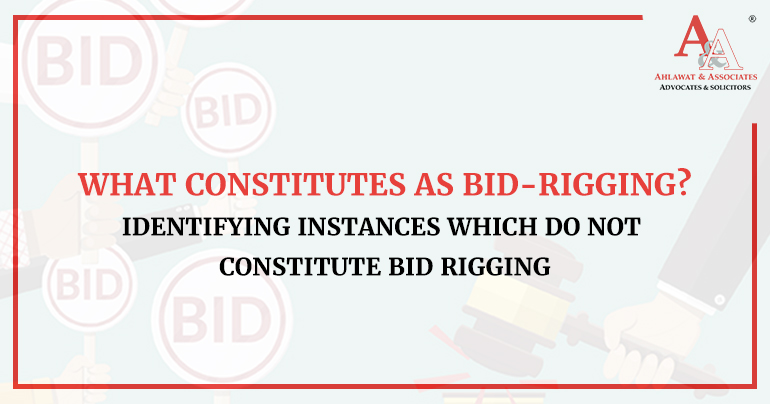
 Sheena Ogra , Anirudh Agarwal
Sheena Ogra , Anirudh Agarwal
 June 16, 2022
June 16, 2022
The Competition Act (“Act”), 2002 has been formulated to deal with the economic realities of the nation wherein it aims at promoting competition on one hand and protecting the Indian markets on the other hand from the claws of the enterprises adhering to the anti-competitive practices in India. The Act predominantly prohibits 3 (three) major segments i.e., abuse of dominant position by enterprises, anti-competitive agreements, and regulates combinations for example mergers, amalgamations, and acquisitions with a view to ensure that there is no adverse effect on competition in markets in India.
The bid rigging or collusive bidding is one of the anti-competitive agreements which is presumed to have an appreciable adverse effect on competition in India. Section 3 (3) of the Act defines, “any agreement entered into between enterprises or associations of enterprises or persons or associations of persons or between any person and enterprise or practice carried on, or decision taken by, any association of enterprises or association of persons, including cartels, engaged in identical or similar trade of goods or provision of services, which--
(a) directly or indirectly determines purchase or sale prices;
(b) ……..
(c) …….
(d) directly or indirectly results in bid-rigging or collusive bidding, shall be presumed to have an appreciable adverse effect on competition:
Provided that nothing contained in this sub-section shall apply to any agreement entered into by way of joint ventures if such agreement increases efficiency in production, supply, distribution, storage, acquisition or control of goods or provision of services.
For the purposes of this sub-section, "bid-rigging" means any agreement, between enterprises or persons referred to in sub-section (3) engaged in identical or similar production or trading of goods or provision of services, which has the effect of eliminating or reducing competition for bids or adversely affecting or manipulating the process for bidding[1].”
Bid rigging is anti-competitive in nature and it takes place when the bid amount is kept at a predetermined level by way of collective efforts of the bidders. Such a predetermined amount is accomplished by way of intentional manipulation by the members of the bidding group. One of the prominent characteristics of the bidders is that they get together and act in concert.
Some of the most common forms of bid-rigging are as follows[2]:
In this article, we are going to analyze what does not fall within the purview of bid-rigging under the Act. For the same, we have hereinbelow examined the landmark judgment which was passed by the Hon’ble Supreme Court of India dated October 1, 2018, wherein, the Hon’ble Supreme Court in the matter of Rajasthan Cylinders and Containers Limited Vs. Union of India (UOI) and Ors[3] analyzed the instances which would not constitute bid rigging. The issue which arose before the Hon’ble Court was whether appellants had indulged in cartelization, thereby influencing and rigging prices, thus, violating provisions of Section 3(3)(d) of the Act. In the instant case, the appellants were suppliers of Liquified Petroleum Gas (“LPG”) cylinders to the Indian Oil Corporation Limited (“IOCL”) and other public sector companies. It was alleged that the appellants indulged in bid rigging by quoting similar prices in their respective bids. An investigation report was carried out by the Director General (“DG”) wherein, the DG observed a similarity in the pattern in terms of price bids submitted by the bidders for various States. Thereafter, the investigation report was submitted to the Commission and based on the findings, the allegation of bid-rigging was confirmed by the Commission along with the Appellate Tribunal.
The Hon’ble Court, however, took a different path and observed that instances of price parallelism while investigating cases of bid rigging need to be looked at from the standpoint of the market conditions. Therefore, the Hon’ble Court noted that where there are few buyers who have significant control over the prices of the goods being sold by the seller then such a situation is referred to as ‘Oligopsony’. In such a situation, parallel pricing would not lead to the conclusion that there was a concerted practice, but other corroborative evidence needs to be taken into consideration to mark anti-competitive behaviour. The Hon’ble Court substantiated this aspect by resorting to the judgement passed by the European Court of Justice which addresses such concept of Oligopsony. Basis the findings, the Hon’ble Court set aside the allegation of bid rigging and held that there was not sufficient evidence to hold that there was an agreement between the appellants for bid rigging.
In the matter of Mr. Virendra Kumar Singh (“Informant”) and M/s Nandal Finance & Leasing Private Limited & M/s JPM Industries Ltd[4](“Opposite Parties”), the Hon’ble Competition Commission of India (“Commission”) in its order dated May 18, 2022, adjudicated on the issue pertaining to the contravention of the provisions of Section 3 of the Competition Act, 2002 (“Act”) which talks about the prohibition of anti-competitive agreements. The said question of law was posed before the Coram comprising of Mr. Ashok Kumar Gupta (Chairperson), Ms. Sangeeta Verma (Member), Mr. Bhagwant Singh Bishnoi (Member).
The issue arose in the backdrop of an alleged bid-rigging, wherein the Informant had filed a case under Section 19 (1) (a) of the Act with respect to the disinvestment process of Central Electronics Limited (“CEL”) wherein it was alleged that there was an interconnection between the Opposite Parties in terms of a common director and both the Opposite Parties had quoted a bid price approximately near the Reserve Price of INR. 194 (Indian Rupees One Hundred and Ninety-Four) Crores. Basis this, the Informant prayed for interim relief under Section 33 of the Act and requested the Commission to order an investigation into the matter and restrain the process of disinvestment of CEL during the pendency of an investigation into bid rigging.
The Informant contended that the disinvestment of CEL to a private company by the Department of Investment and Public Asset Management (“DIPAM”) had been done at a very low price despite it being a profit-making company having valuable assets. Further, there was no transparency in the process and no clarity in terms of the disinvestment process was provided to the employees working in CEL as well as to the public at large. In addition to this, it was also contended by the Informant that a liquidation case was going on against one of the Opposite Parties before the Hon’ble National Company Law Appellate Tribunal (“NCLAT”). Therefore, the opposite party should have been disqualified from bidding in the disinvestment process.
The DIPAM on the other hand contended that CEL’s disinvestment was undertaken on an express recommendation of NITI Aayog, and the disinvestment process was carried out in a transparent manner and in accordance with the process and guidelines laid down by DIPAM. The reserve price of INR. 194 (Indian Rupees One Hundred and Ninety-Four) Crores was arrived at using approved methodologies and international best practices by a transaction advisor and an asset valuer. In addition to this, DIPAM contended that one director being common in both the Opposite Parties does not establish a statutorily recognized relationship between them.
The Commission opined that prima facie there was nothing to indicate that the bidders were aware of the reserve price prior to bidding and that the bidding price was quoted jointly. In addition to this, the Commission observed that “merely having common directors/partners may not, ipso facto, give rise to anti-competitive concerns, in the absence of other material factors to indicate that such common relationship facilitated a few entities to come together and manipulate the bid process”[5].
The Commission in one of its orders dated April 4, 2022, held that “It may not be entirely uncommon, where a common Promoter/Director acts as a link between two entities, to facilitate anti-competitive behaviour. However, there is no presumption that it has to be that way at all times; instead, it will depend upon the attendant factual matrix. Thus, the Commission is of the view that merely having common business linkages between the bidders as projected by the Informant, in itself, cannot be the sole basis to suggest meeting of minds or assentio mentium between the bidders in the bidding process[6].”
As far as the allegations are concerned, the Commission was of the opinion that no prima facie case exists and that the provisions of Section 3 of the Act will not be applicable against the Opposite Parties. The Commission through this order ensured that having a common director need not necessarily give rise to anti-competitive behaviour.
The Hon’ble Supreme Court of India clarified the position that instances of price parallelism need not necessarily attract bid rigging and the situation needs to be looked at from the standpoint of the market conditions. To mark anti-competitive behaviour, other corroborative evidence needs to be taken into consideration and mere parallel pricing would not lead to the conclusion that there was a concerted practice. Furthermore, the Commission also recently clarified through one of its orders that merely having a common director/partner in the group company need not give rise to anti-competitive concerns. There are other material factors which need to be taken into consideration to indicate that there is a possibility of anti-competitive behaviour but again, it depends on the facts and circumstances of each case.
[1] Sub-section (3) of Section 3 of the Competition Act, 2002.
[2] CCI Advocacy Booklet for Bid Rigging.
[3] 2018 (4) CCC 376
[4] Case No. 11 of 2022
[5] Case No. 11 of 2022
[6] Case No. 25 of 2021

Explore the comprehensive legal framework governing e-signatures and e-contracts in India. Gain insights into the regulations and implications for electronic transactions.
View More
The Securities and Exchange Board of India (“SEBI”) in an announcement in December 2022
View More
As per Section 2(41) of the Companies Act, 2013 (“Act”), financial year, in relation to any
View More















 Cookies Consent
Cookies ConsentWe use cookies to help you navigate efficiently and perform certain functions. You will find detailed information about all cookies under each consent category below. Read more...
 Cookies Consent
Cookies ConsentWe use cookies to help you navigate efficiently and perform certain functions. You will find detailed information about all cookies under each consent category below. Read more...


Comments
Post A Comment
Your email address will not be published *